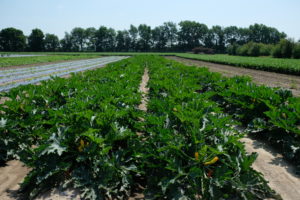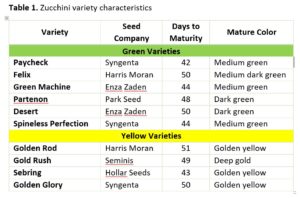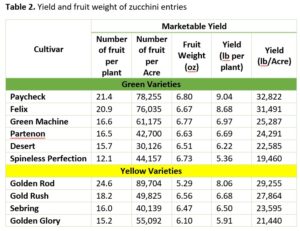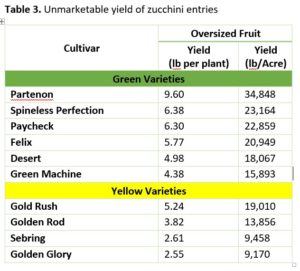Gowers always want to know which variety is the most suitable one for their farming location and market. I do understand the frustration of growers when looking online at all the varieties being sold by different vendors. There are a plethora of varieties available that have different fruit types and growth habits. Characteristics like potential yield and disease resistance are always important considerations for growers. Which variety will work best for my farming operation and market? During 2018, I attempted to address growers’ concerns and need for local variety performance data, hosting a zucchini field trial at the Throckmorton Purdue Agriculture Center/Meigs Horticulture Facility, Lafayette, Indiana.
How was the evaluation conducted?
Soil of the test plot comprised of a Toronto-Millbrook (47%) complex, Drummer (27%) and Starks-Fincastle complex (26%) (ranged from a silt loam to silty clay loam). The spring 2018 soil test showed 2.8% organic matter, pH 5.7, and 34 ppm phosphorus (P), 83 ppm potassium (K), 245 ppm magnesium (Mg), and 1500 ppm calcium (Ca).The cation exchange capacity was 13.4 meq/100 gram. Micro nutrients tested at 2.0 ppm zinc (Zn), 29 ppm manganese (Mn), 49 ppm iron (Fe), 1.6 ppm copper (Cu) and 0.3 ppm boron (B). On May 8, 660 lb/A 9-23-30 was applied pre-bedding. At bedding (May 25) 140 lb/A 46-0-0 was applied.
The ten zucchini varieties (Table 1) were grown in raised beds covered with a 4 feet wide black plastic mulch (Fig. 1). Drip tape with a 12-inch emitter spacing and flow rate of 0.22 gpm/100 ft was used for irrigation. The zucchini entries were seeded May 7 and transplanted into raised beds (2 feet wide) on May 28 with an in-row spacing of 2 feet and between-row spacing of 6 feet (3,630 plants per acre).

Figure 1. Raised bed covered with plastic mulch. Bed spacing at 6 ft center-to-center with in-row spacing at 2 ft. Picture was taken 5 weeks after transplanting.
Diseases were managed by scouting and using recommendations from the Midwest Vegetable Production Guide for Commercial Growers (Egel et al., 2018). Bravo Weather Stik®, Cuprofix 40 UltraDisperss Initiate®, Cabrio®, Fontelis®and Bravo® were rotationally sprayed for disease control. Assail® and Warrior® were used for insect control. Weeds were controlled with Strategy® (pre-emergence) and Sandea® (pre-emergence and post-emergence). All herbicides were broadcast applied pre-plant after plastic was laid on the raised beds.
The zucchini was harvested three times a week (Monday, Tuesday and Friday) between June 18 and July 18. Fruits were harvested when they reached 6 to 8 inches in length. For each variety the marketable and unmarketable number of fruits were recorded. Fruit that was more than 8 inches long was classified as unmarketable.
How did the varieties perform?
The number of marketable fruit and yield per acre, as well as fruit weight differences among entries were significant (Table 2). Paycheck and Felix produced the most fruit and highest yield per acre (32,822 and 31,491 lb, respectively) of all the green zucchini entries tested. Spineless Perfection produced the lowest yield (19,460 lb/acre). Golden Rod produced the highest number of fruit per acre (89,704) followed by Gold Rush (49,825). However, there was not a significant difference between the yield of Golden Rod and Gold Rush (29,255 and 27,864 lb/acre, respectively). This was due to the higher fruit weight of Gold Rush (6.56 oz). The presence of disease and insects were very low and did not impact yield.
Unmarketable yield differences between entries were significant (Table 3) and was mainly attributed to oversized fruit. Partenon produced the highest unmarketable yield of all the green zucchini entries (34,848 lb/acre), while Green Machine produced the lowest unmarketable yield (15,893 lb/acre). The yellow zucchini varieties produced overall lower unmarketable yields’ than the green zucchini entries. Unmarketable yields varied between 9,170 and 19,010 lb/acre. Other than the fruit being too large, these entries were very strong producers. Marketable yields could have improved if they were harvested more frequently. Daily harvests are encouraged for very vigorous varieties, especially green zucchini varieties such as Paycheck, Felix, Green Machine and Partenon and yellow zucchini varieties such as Golden Rod and Gold Rush. Gold Rush and Sebring also produced fruit with green tips.
In summary, the best performing green zucchini squash entries include Paycheck, Felix, Green Machine and Partenon. Golden Rod and Gold Rush were the best performing yellow zucchini entries. A detailed report of the ten zucchini varieties tested is available in the 2018 Midwest Vegetable Trial Report https://ag.purdue.edu/hla/fruitveg/Pages/mvtr2018.aspx.
I would like to acknowledge the Indiana Vegetable Growers Association (IVGA) for co-funding this evaluation.
Literature Cited
Egel, D., Foster, R., Maynard, E., et al. 2018. Midwest Vegetable Production Guide for Commercial Growers, 2018 (ID-56). Purdue University. https://ag.purdue.edu/btny/midwest-vegetable-guide/Pages/default.aspx


